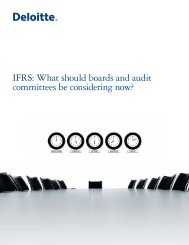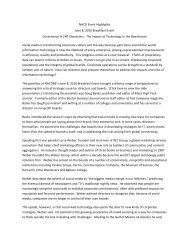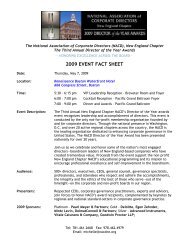NACD Event Highlights March 8, 2011 Breakfast ... - New England
NACD Event Highlights March 8, 2011 Breakfast ... - New England
NACD Event Highlights March 8, 2011 Breakfast ... - New England
Create successful ePaper yourself
Turn your PDF publications into a flip-book with our unique Google optimized e-Paper software.
venture firm Greylock Partners, President and COO of Rational Software until its acquisition by IBM in <br />
2003, and CEO of Avatar Technologies and Pacific Data Products. <br />
Jay Bothwick played the role of outside counsel. A partner in the Corporate Practice Group at <br />
WilmerHale, he joined the firm in 1981. He focuses his practice on mergers and acquisitions, and has <br />
significant experience in venture capital and corporate finance transactions as well. Bothwick has <br />
advised public and private companies, both domestically and overseas, in mergers and acquisitions, <br />
tender and exchange offers, proxy contests and public and private offerings. <br />
Playing the role of investment banker was Tom Cibotti, Managing Director at Covington Associates LLC, a <br />
Boston-‐based specialty investment banking firm serving the middle market sector for more than 20 <br />
years. He joined the firm in 1993 and has more than 20 years of transaction-‐related experience across <br />
many sectors. He has completed more than 60 buy-‐side and sell-‐side assignments representing more <br />
than $6 billion in transaction value. <br />
Scenario <br />
The CEO of an NYSE-‐listed technology company (the “Company”) with annual revenues of $500 million <br />
and a $1.25 billion market cap has discovered a potentially strategic acquisition target (the “Target”) she <br />
believes is undervalued. The Company has built a solid reputation on Wall Street and its hardware and <br />
software products and solutions are in a category that is evolving from “nice to have” to strategic for its <br />
customers, but demand for its products is mediocre. The CEO wants to move fast on the Target. It has <br />
interesting intellectual property and highly competitive, complementary products, while being smaller <br />
and more leveraged than the Company. The Target’s stock market performance has been choppy. <br />
Despite a thoughtful and often impassioned pitch by the CEO, both the CFO and lead director initially <br />
are not persuaded on the merits of the deal. They are concerned about the Company’s lack of a <br />
developed acquisition strategy, potential execution risks, and whether the CEO has sufficiently <br />
accounted for economic conditions or adequately considered alternative approaches, such as <br />
accelerating the Company’s organic growth. The lead director’s hesitancy also stems from the fact that <br />
the Company has only recently paid down its previously burdensome debt, coming close to violating <br />
debt covenants before doing so. <br />
The CFO and lead director’s resistance softens when the Company’s outside counsel and investment <br />
banker articulate their perspectives on the deal. The investment banker describes the current <br />
transaction environment, outlines his valuation analysis, and discusses the prospects for operational <br />
synergies and earnings accretion. The outside counsel discusses ways to structure the transaction and <br />
execute the board’s legal and fiduciary responsibilities. At that point the lead director opens the <br />
meeting to the “board members” attending the event. <br />
The Audience Weighs In <br />
2





